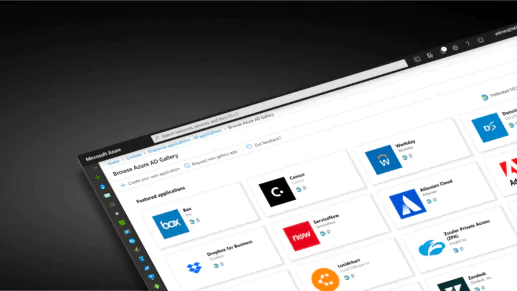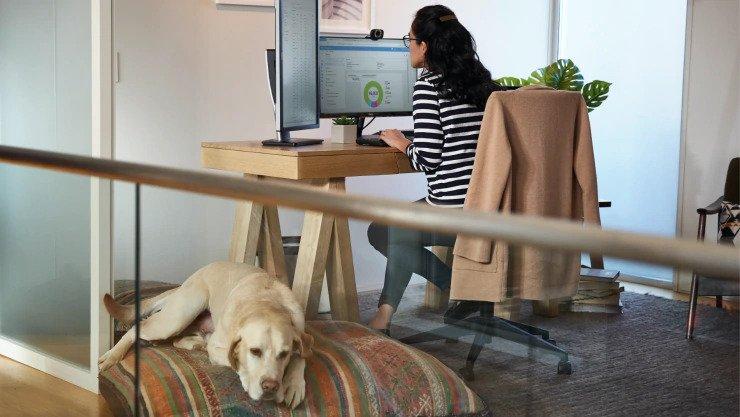Enable employees to work remotely and stay more secure
Help your employees now working from home remain productive and secure using Microsoft solutions.
Help your employees now working from home remain productive and secure using Microsoft solutions.

Establishing identity management in the cloud is your first step. Microsoft Azure Active Directory (Azure AD) lets you manage authentication across devices, cloud apps, and on-premises apps. With single sign-on, your employees can access resources from any device while working remotely.

Your business-critical apps may not be setup for access from outside the corporate network. Use Azure AD Application Proxy, a lightweight agent, to enable access to your on-premises apps without opening up broad access to your network. Combine it with existing Azure AD authentication and Azure Active Directory Conditional Access policies to help keep users and data secured.

Partnering with other organizations becomes more challenging without in-person meetings. You need to create and maintain relationships no matter where you are by removing barriers to remote interaction. Grant access to the right apps with a single sign-on experience. Ensure appropriate access to your organization’s resources anytime, anywhere, by applying a greater level of security and governance for partners.

Multi-factor authentication (MFA) is the single best thing you can do to improve security for remote work. If you’re not able to distribute hardware security devices, use biometrics or mobile device authentication apps like Microsoft Authenticator as the second factor.
Many organizations are increasing the use of personal devices to enable remote work. Azure AD Conditional Access and Microsoft Intune app protection policies together help manage and secure corporate data in approved apps on personal devices.

Microsoft Intune lets you manage both company-owned and employee-owned devices from the cloud. It allows you to manage across devices (laptop, tablet, and mobile device) and operating systems (iOS, Windows, and Android). Set up your Intune subscription then add users and groups of users, assign licenses, deploy and protect apps, and set up device enrollment.

Azure AD Conditional Access is the Microsoft identity security policy hub. Create Conditional Access policies according to user, device, application, and risk. Enforce controls that allow a device trying to access a specific resource only if it’s compliant.

Phishing is a primary point of entry for attackers and recent world events have provided them a new opportunity to trick users into clicking on lures. For security against malicious emails, Office 365 Advanced Threat Protection lets you set up antiphishing protections to help protect your employees from increasingly sophisticated attacks.

The Microsoft Defender Advanced Threat Protection integrated suite of pre- and post-breach protection capabilities helps your security team protect your environment and scale and operate efficiently while being remote. Take advantage of Threat and Vulnerability Management, attack surface reduction, and auto investigation and remediation today. These features require relatively low effort to leverage and can have the greatest impact in helping to drive better security and improved efficiencies.

Remote workers often need access to a variety of business-critical cloud apps to do their jobs. Use Microsoft Cloud App Security to monitor session risk, gain visibility into usage, and enforce app and file usage policies in real time. Maintain productivity by educating and guiding workers to access the cloud resources they need through more secure methods.

Once you’ve deployed your security infrastructure, ensure you’re taking full advantage of its capabilities with an optimized configuration. Identify potential posture improvements and develop and implement a plan to get the most security out of your Microsoft 365 and Azure workloads with Microsoft Secure Score.

Now, more than ever, remote work capabilities are vital. Ensure your workforce is as efficient working from home as they were at the office. In this webinar you’ll learn how Microsoft Azure Active Directory helps improve efficiency while maintaining the right balance of productivity and security for remote workers.

With the increase in remote work, legacy network architectures are suddenly under enormous strain. Many organizations are now rethinking their network infrastructure design, especially for apps such as Office apps and Microsoft Teams. In this webinar, we provide guidance on how to manage security in the changing environment.

Dealing with passwords is challenging for many companies. Breaches happen if passwords aren’t augmented or replaced with stronger authentication methods that are easily adopted by users. Learn why passwords don’t protect you from most attacks (but MFA does) and how to find the right options for your company and your users. We’ll also share how Microsoft can help you start eliminating passwords in your environment.